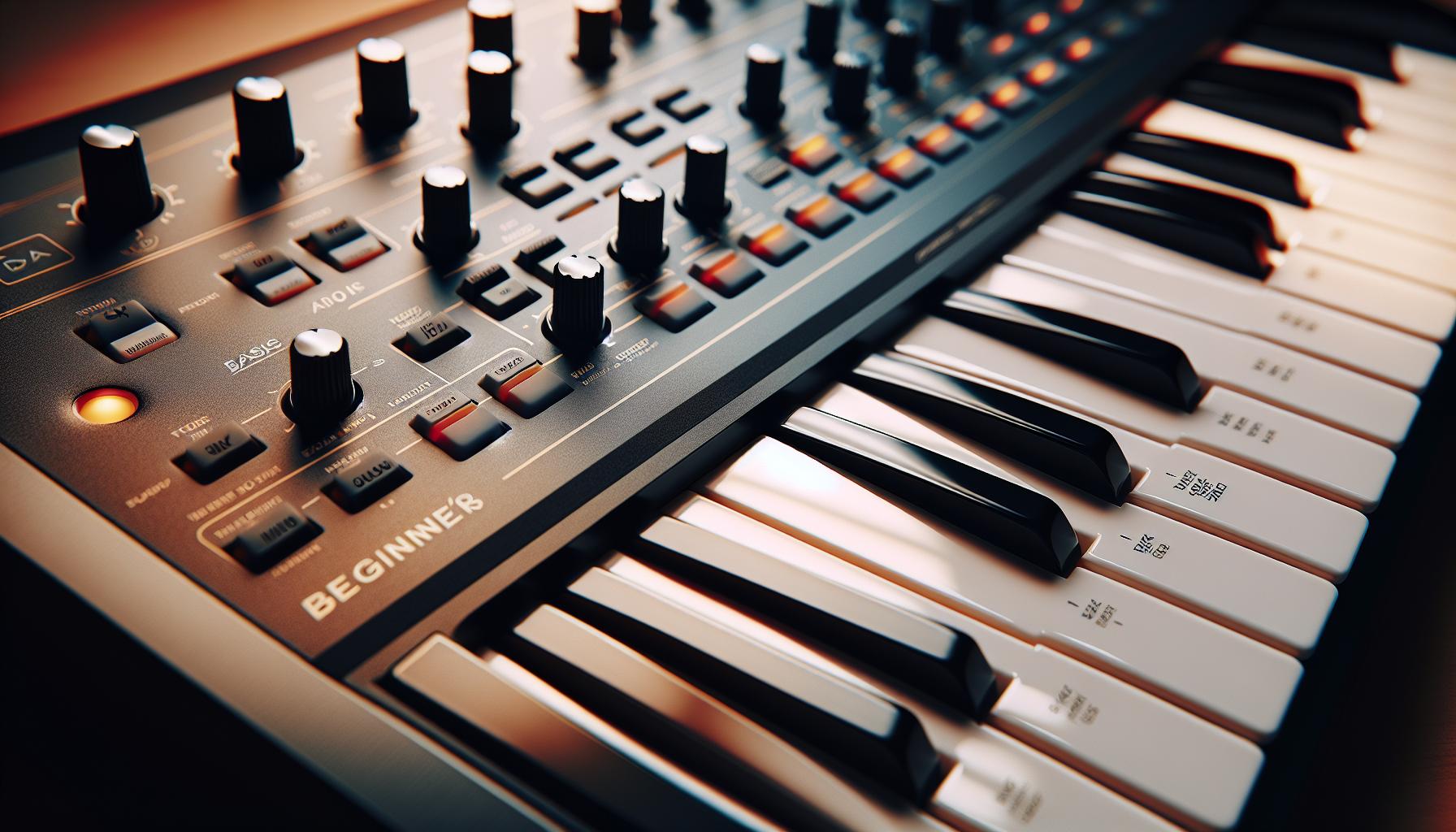Finding the perfect beginner keyboard can be a daunting task, especially when you're after that rich, deep bass sound that gives music its soulful edge. It's not just about hitting the right notes; it's about feeling the groove and laying down those foundational bass lines that make your heart thump.
Luckily, the market is brimming with options tailored for newcomers eager to explore the lower octaves without breaking the bank. Whether you're into jazz, rock, or electronic music, there's a beginner keyboard out there with your name on it, ready to deliver those delicious bass sounds that'll get your creative juices flowing. Let's dive into what makes a keyboard stand out in the bass department and how to pick the right one to kickstart your musical journey.
Understanding the Importance of Bass in a Keyboard
When exploring the musical spectrums available in a keyboard, bass plays a pivotal role in bringing music to life. Bass sounds provide the foundational layer upon which melodies and harmonies build, creating a full, rich sound experience. For beginners, understanding the importance of bass in music is essential, as it not only enhances the depth and emotion in pieces but also serves as the backbone for rhythm and groove.
Keyboards with good bass capabilities are invaluable for newcomers trying to grasp the essence of various music genres. Whether it's the soulful undertones in jazz, the driving force in rock, or the pulsating beats in electronic music, bass is the common thread that ties the emotions and rhythm of a song together. It's about more than just hitting the low notes; it's about feeling the groove and establishing a solid foundation for other instruments to shine.
Moreover, keyboards that offer rich bass sounds can significantly impact a beginner's learning experience. They allow for a more immersive practice session, enabling learners to better understand the role of each note and chord in the context of the full musical piece. This not only improves their technical ability to play but also deepens their musicality and appreciation for different styles.
Selecting a keyboard with robust bass features entails consideration of several aspects:
- Sound Quality: The essence of a good bass sound lies in its clarity and depth. Beginners should look for keyboards that offer crisp, clear bass tones that mimic the sounds of their acoustic counterparts.
- Range of Sounds: A keyboard with a variety of bass sounds and effects can provide beginners with a playground to explore different musical genres and textures.
- Touch Sensitivity: The responsiveness of the keys to touch can greatly affect the nuance of bass sounds. Keyboards with adjustable touch sensitivity allow users to experiment with the dynamics of bass lines.
Understanding these factors can dramatically enhance a beginner's journey in music, making the selection of a keyboard with good bass sounds a crucial step. Through the right equipment, beginners can truly feel the music they create, laying down solid bass lines that breathe life into their compositions. Equipped with a suitable keyboard, they're set to explore the depths of music, one note at a time.
Features to Look for in a Beginner Keyboard for Rich Bass Sounds

When embarking on the musical journey of learning to play the keyboard, beginners should keep an eye out for several key features that can significantly enhance the richness of bass sounds. These features not only contribute to a more immersive learning experience but also aid in developing a keen ear for music.
Sound Quality and Range: The cornerstone of a good beginner keyboard is exceptional sound quality, particularly when it comes to bass sounds. Keyboards that offer a wide range of sounds, including deep bass tones, allow beginners to explore various music genres and techniques. High-quality sound samples and a broad sound palette are indicative of a keyboard designed to deliver an engaging musical experience.
Touch Sensitivity: Beginners will find that keyboards with touch-sensitive keys offer a more dynamic playing experience. The ability to control the volume and tone of the bass sounds through the pressure applied to the keys mimics the expressiveness of traditional acoustic instruments. This feature is invaluable for learners as it encourages the development of a nuanced touch and a deeper understanding of musical expression.
Polyphony: Polyphony refers to the number of sounds a keyboard can produce at one time. For a rich bass experience, a keyboard with a high polyphony count is recommended. This ensures that bass tones do not get cut off or compromised when playing complex chords or when layering sounds. With a higher polyphony, beginners can experiment with intricate bass lines without sacrificing sound quality.
Built-In Bass Effects: Keyboards equipped with built-in bass effects, such as equalizers and bass boost, offer beginners the opportunity to customize their sound. Experimenting with these effects can be a fun and educational way for learners to discover their preferred bass tones and how they fit into different musical contexts.
Connectivity Options: While not directly related to bass sounds, connectivity features such as USB and MIDI ports allow beginners to expand their musical resources. By connecting to computers and mobile devices, learners can access a vast array of educational apps, recording software, and additional sound libraries, including rich bass sounds.
- Sound Quality and Range: Look for keyboards with high-quality sound samples and a variety of bass tones.
- Touch Sensitivity: Choose keyboards with touch-sensitive keys for expressive playing.
- Polyphony: Opt for keyboards with
Top Beginner Keyboards with High-Quality Bass Capabilities

When on the hunt for the perfect beginner keyboard that doesn't compromise on bass quality, there are several standout models that promise to deliver rich, deep sounds. The market is flooded with options, but a few have risen to the top, celebrated for their superior bass capabilities and beginner-friendly features. These keyboards not only make learning more enjoyable but also ensure that the bass tones are as authentic and inspiring as possible.
The Yamaha PSR-EW310 is widely recognized for its impressive sound quality. It boasts a potent 76-key setup, ideal for exploring a wide range of bass tones. The PSR-EW310 also comes embedded with Touch Sensitivity that mimics the nuanced dynamics of an acoustic piano, the PSR-EW310 allows beginners to experiment with subtle variations in bass pressure and intensity. Additionally, it offers 482 high-quality voices, including incredible bass patches, making it a top choice for those prioritizing bass sound richness in their musical journey.
Another notable mention is the Casio CTK-3500. It shines with its Step-Up Lesson System, a boon for beginners eager to grasp music fundamentals while honing their bass playing skills. With 400 tones and 150 rhythms, it offers vast opportunities to dive into different musical styles, all while maintaining a powerful bass presence. Like the Yamaha, it includes 61 touch-sensitive keys, ensuring a responsive and dynamic playing experience.
Here's a quick comparison of features between these two models:
| Feature | Yamaha PSR-EW310 | Casio CTK-3500 |
|---|---|---|
| Keys | 76 | 61 |
| Touch Sensitivity | Yes | Yes |
| Polyphony | 48 notes | 48 notes |
| Preset Voices/Rhythms | 482 voices, Built-in bass effects | 400 tones, 150 rhythms |
| Connectivity | USB to HOST, AUX IN | USB, Audio-In |
| Added Benefits | Wide range of bass samples, Yamaha Education Suite | Dance Music Mode, Step-Up Lesson System |
Tips for Getting the Most Out of Bass Sounds on Your Keyboard

Playing a keyboard that boasts good bass sounds is thrilling for any beginner. However, mastering these sounds to create truly mesmerizing music involves more than just hitting the right notes. Here are some practical tips to help you get the most out of the bass sounds on your keyboard.
Experiment with Different Settings
Each keyboard comes with its unique set of features and settings tailored to enhance your playing experience. To find the perfect bass sound, it's crucial to experiment with these settings. Playing around with the equalizer (EQ) can significantly alter the richness and depth of the bass. Boosting the lower frequencies while maintaining a balance with the mids and highs can bring your bass sounds to life. Additionally, using effects like reverb and chorus sparingly can add dimension without overwhelming the clarity of the bass.
- Equalizer settings: Boost lower frequencies
- Effects: Use reverb and chorus sparingly
Understanding Layering and Splitting
Many beginners overlook the power of layering and splitting functions on their keyboards. These features allow you to play multiple voices or instruments simultaneously or divide the keyboard into different sections, each with its unique sound. By layering a bass sound with another instrument, like a piano or pad, you can create a fuller, more complex sound. Splitting the keyboard lets you assign a bass voice to the left hand while playing melodies or chords with the right, simulating the dynamic of a live band.
Play Along to Different Genres
Diversity in practice can significantly improve your command of bass sounds. Playing along to songs from various genres exposes you to different bass line techniques and rhythms. Jazz, funk, and reggae, for instance, offer complex bass lines that challenge your timing and finger independence. Meanwhile, pop and rock songs can help you understand the role of bass in driving a song's groove. This experience not only enhances your playing technique but also broadens your musicality, making your performances more versatile and engaging.
Conclusion
Choosing the right beginner keyboard with impressive bass sounds boils down to understanding your musical needs and experimenting with the features at your disposal. The Yamaha PSR-EW310 and the Casio CTK-3500 stand out not just for their quality but also for the creative freedom they offer. By leveraging the tips provided—like tweaking the equalizer settings and exploring the layering functions—you're setting the stage for a richer, more immersive bass experience. Remember, the journey to mastering bass on your keyboard is a mix of the right tools and a lot of practice. So dive into different genres, play along, and watch as your skills and musical versatility grow. Happy playing!
Harlan Kilstein began playing piano during covid with no piano background at all. He taught himself how to play learning what to do and what not to do.
Today he's an advanced intermediate player and can help you grow in your skills because he learned all this on his own.







